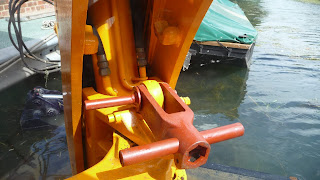There's a great satisfaction when you can embark on a quest to produce something from the 'junk' that is to hand - a sort of Scrapheap Challenge.
We wanted to make a transit hanger for the Pat's heavy jib (Item 1), a rough idea of the design had been sketched with a borrowed pen on a recycled piece of corrugated cardboard. 10 minutes spent routing around in one of the containers and various other likely places produced the makings of component.
A casting which had a couple of forks at the right spacing, which given the chop in a suitable place and the holes made/modified, really looked the part. Bars were produced to complete the assembly and the bits welded together.
In a rash dose of over-confidence, we actually applied the first coat of red oxide and together with item 2, headed off to the boat for a trial fitting.
Item 2
You may remember that a new flexible coupling for the exhaust was sourced. This had to be grafted onto the two flanges from the broken part. The new coupling was welded in place, double checking the overall length which had to fit the gap in the engine room.
In order to test Item 1, It was extremely desirable to have Item 2 in place to start the engine! One thing immediately apparent was that the engine vibration now coupled quite well into the metal structure of the cabin, with a resonance that occurred near tickover. We raised the revs slightly to avoid this resonance, which also ensured the alternator charged the battery. We're considering fitting a second flexible joint.
Up the front, Item 1, was a great success. All the parts fitted correctly first time and it did the job. The first coat of yellow paint has now been applied. It will be possible to leave it fixed to the lower eye and drop it in over the hooks when required to park the jib in the transit position.
Now, to Item 3.
Much thought is being given to the safety of deploying the spud legs at 90 degrees, which involves inserting a rod, releasing a pin and cranking it round. Our first improvement was to make an extension piece that could extend the rod, so that the forces taken to shift it were reduced. This worked well. Further thinking is needed and initial ideas as to what else can be done are beginning to take shape, but not physically - yet.






